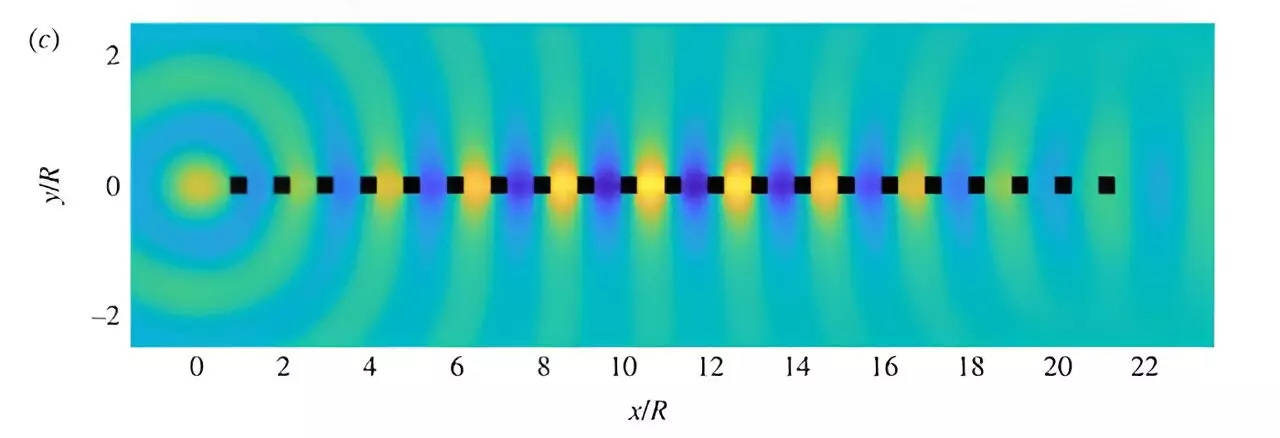Recent developments at Macquarie University herald a transformative phase in the field of metamaterials—a realm poised at the intersection of materials science and wave physics. Researchers have unveiled TMATSOLVER, a sophisticated software package designed to accurately model the behavior of various waveforms—whether sound, light, or water—when interacting with complex particle arrangements. The research, published in the prestigious *Proceedings of the Royal Society A* on June 19, 2024, signifies not only a technological leap but also broadens the horizons for designing artificial materials that can manipulate wave propagation in innovative ways.
Metamaterials, by virtue of their specially engineered configurations, exhibit extraordinary properties that transcend those found in naturally occurring materials. These properties allow for unprecedented control over electromagnetic and acoustic waves, laying the groundwork for advancements that include superlenses, invisibility cloaks, and advanced energy-harvesting systems. However, the complexity involved in simulating intricate particle arrangements has historically posed a significant challenge for researchers and engineers alike.
At the heart of TMATSOLVER lies the Transition Matrix (T-matrix), a robust mathematical construct that characterizes wave scattering behaviors across different particle shapes and sizes. Lead author Dr. Stuart Hawkins emphasizes the core innovation here: “While the T-matrix concept has been prevalent since the 1960s, our advancements enable precise computations even for particles significantly larger than the wavelengths of interest.” This capability empowers researchers to explore previously inaccessible configurations, greatly enhancing the modeling of metamaterials that are critical for various applications.
The collaborative effort, which involved mathematicians from prestigious institutions including the University of Adelaide, the University of Manchester, Imperial College London, and the University of Augsburg, showcases the global nature of this endeavor. Dr. Luke Bennetts, a co-author of the study, highlighted how TMATSOLVER eliminates the computational bottleneck that previously hindered metamaterial research. By streamlining the simulation process, researchers can efficiently tackle complex geometries and test new metamaterial theories without delay.
The researchers demonstrated TMATSOLVER’s capabilities through a series of practical examples, tackling challenges associated with diverse particle configurations. Among the scenarios tested were arrays of anisotropic particles and high-contrast square particles, as well as tunable periodic structures capable of modifying wave speed. These case studies underscore the software’s versatility in simulating complex metamaterial configurations and illustrate its potential to push the boundaries of current metamaterial technology.
The implications of this project are profound. The newfound ability to quickly simulate and prototype metamaterials paves the way for rapid innovation across various industries, including telecommunications, energy, and environmental science. Applications of these advanced materials may soon lead to breakthroughs in everything from stealth technology to enhanced imaging systems and soundproofing solutions.
Professor Lucy Marshall, Executive Dean of the Faculty of Science and Engineering at Macquarie University, noted the far-reaching consequences of this research, stating, “This software is a monumental advancement in our capacity to design and simulate complex metamaterials. It exemplifies the synergistic potential of computational innovation and materials science, driving progress in numerous scientific and engineering domains.”
With the global market for metamaterials on the rise, the introduction of TMATSOLVER not only enhances research capabilities but also potentially accelerates the commercialization of metamaterials designed for specialized wave control applications. As this technology continues to develop, researchers and industries alike are poised to benefit from TMATSOLVER’s powerful modeling capabilities, forging a path toward a future where advanced materials will play an integral role in technological advancements.
TMATSOLVER marks a significant stride in metamaterials research, allowing for complex particle interactions to be modeled with unprecedented accuracy and efficiency. As researchers refine these tools and methodologies, the next generation of metamaterials is likely to emerge, significantly altering our interaction with waves and materials in ways we are only beginning to imagine.


Leave a Reply